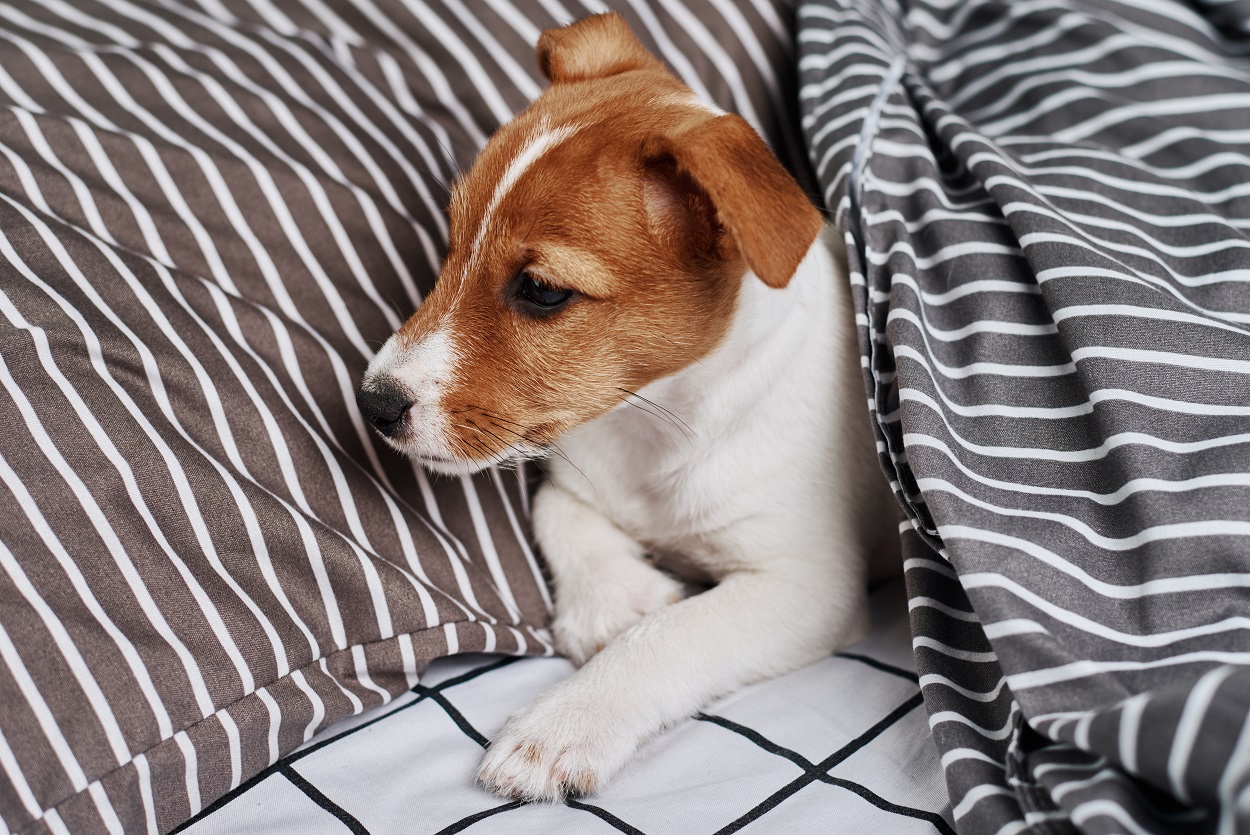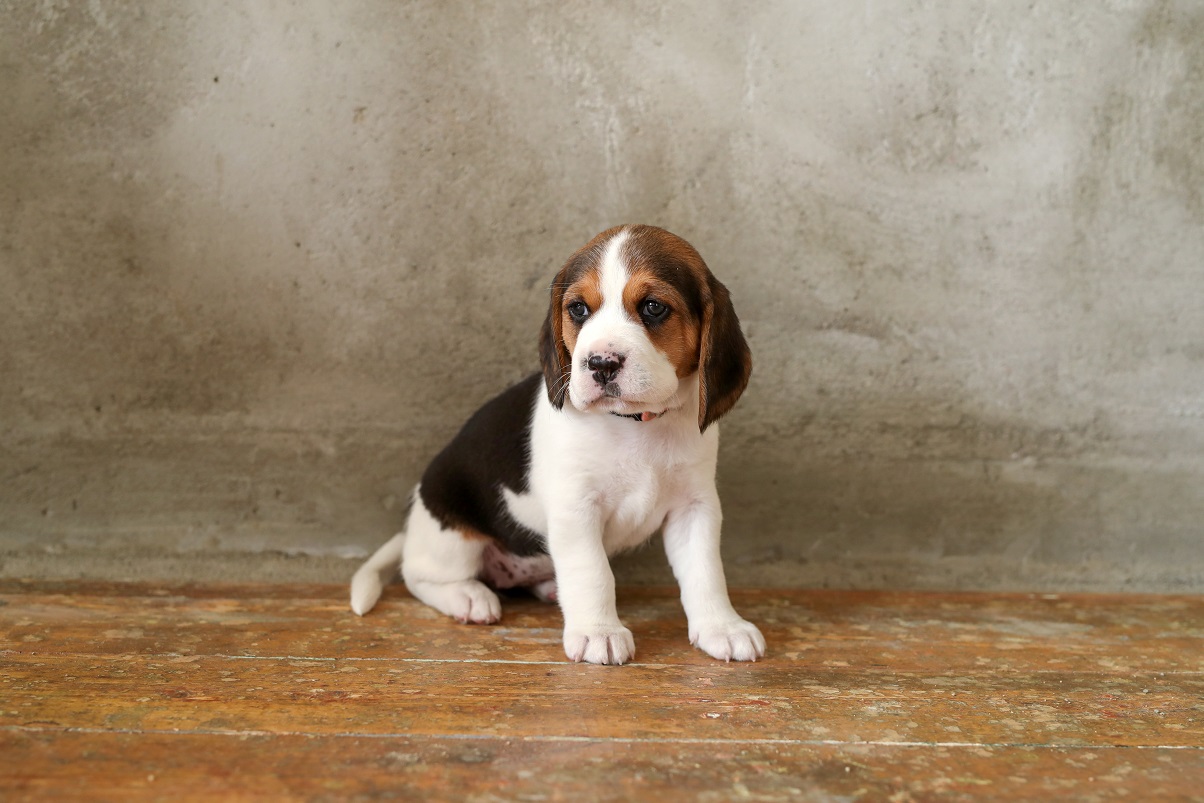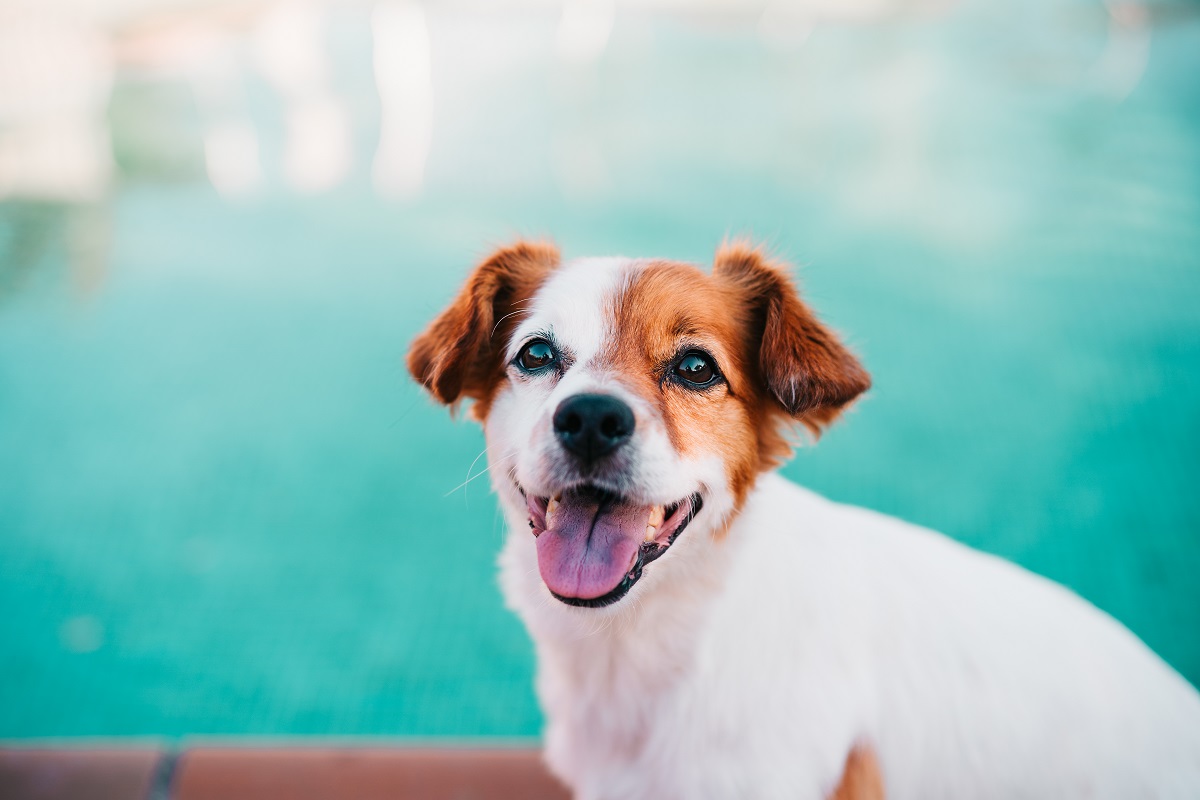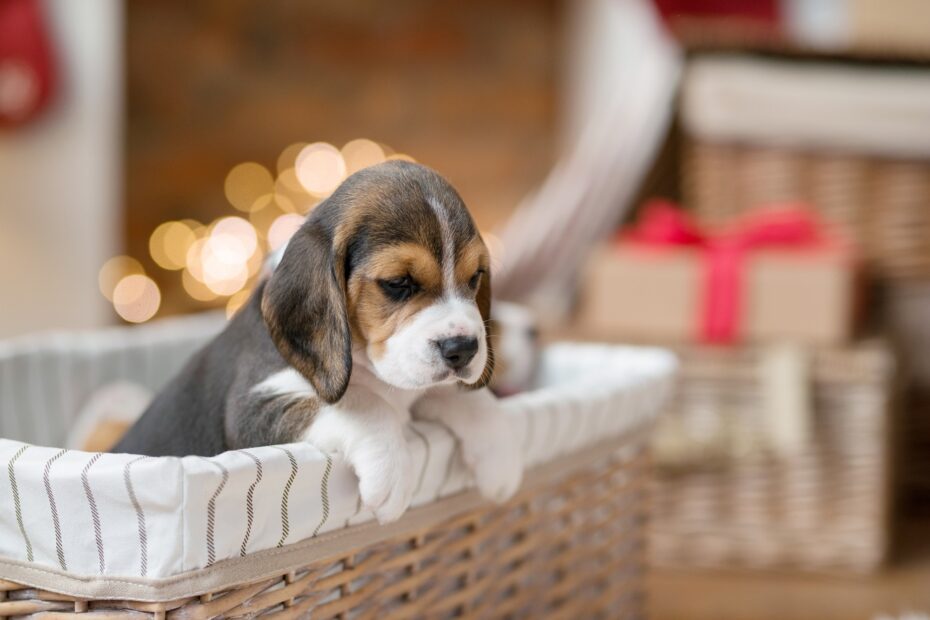If you’re considering drawing up a crate training schedule for a puppy, then well done on an excellent plan!
It’s not news that crate training is an invaluable tool when it comes to potty training. But believe it or not, crates can do way more than teach your puppy how to exercise bladder control.
Crates appeal to your dog’s natural instinct to seek out a quiet, safe, comfortable place to rest and regather.
When it’s time for bed, the crate is a comfortable, cozy resting place.
When the house is noisy or full of distractions, it’s a safe sanctuary away from the clamor.
Far from being a ‘doggy prison’ (as some people think), a crate is a reassuring place of refuge.
But there’s a caveat to all this.
If crate training is done badly (or not at all), then that crate you just spent a fortune on is never going to be loved in the way it should. Your dog might end up resenting it, even hating it.
Lock them in it for too long, too soon; forget to make it comfortable; or commit any other crate training cardinal sins. And you can kiss goodbye to the idea of that safe sanctuary.
If you want to avoid that, you can. You just need to go into the process informed. Educate yourself on things like schedules, common teething problems, and several other key areas, and your chances of success increase a hundredfold.
Now, if you want to learn an easy way to train your puppy, then I highly recommend checking out the Puppy Coach Program from Dan Abdelnoor (aka Doggy Dan) over at The Online Dog Trainer.
Just to tell you a little more, Dan’s put together a complete step-by-step program that’ll take you through everything you’ll ever need to know about raising the perfect pup.
You’ll get access to how to deal with crate training problems, potty issues, and a complete video diary of how Dan raised his youngest pup Moses into a fully grown adult dog.
Anyway, here’s the link to take a look: Puppy Coach Program By Doggy Dan

The Difficulties of Crate Training a Puppy
The first rule of crate training? Don’t go into this thinking it’s going to be a walk in the park.
Some dogs will take to the crate like a fish to water. Others won’t.
Teething problems are natural, they’re normal, and providing you know what to expect (and know what to do when they happen), they shouldn’t stand in the way of success.
Some of the most common problems you might encounter include:
Crate Refusal
Some pups may be so overwhelmed at the sight of their shiny new crate and refuse point blank to go in it. And no matter how much you beg, they’re having none of it.
The problem can usually be overcome by reconditioning your pup’s attitude toward the crate.
First of all, make it as cozy as possible. Make it the kind of place you wouldn’t mind spending time in, let alone your dog.
Once that’s done, grab a pack of treats you know your pup can’t resist and scatter a few just inside the door. Gradually entice them in by tossing the treats further back inside.
Once they’re in, hand feed them treats through the bars to encourage them to stay put.
Once they’re comfortable, close the door softly, feed them a few more treats through the door, then let them out.
Keep practicing the routine, gradually increasing the length of time you keep the door closed.
Frustration Barking
If your puppy starts barking inside the crate, it could be a sign they need the bathroom.
But equally, it could be a sign they’re a bit bored of this crate business and would far rather you let them out and play, please.
While you should never ignore a bathroom call, teaching your pup that demand barking doesn’t work is equally important.
Always make sure they’ve had a chance to use the bathroom before putting them in the crate. If you’re confident they don’t need to use it again, ignore the barking.
When they quiet down, mark the behavior with praise and a treat before you let them out. It can also help to give them a safe chew toy to gnaw on to avoid boredom barking.

Crate Induced Panic
There’s a huge difference between a dog who’s barking out of frustration and one who’s barking because they’re genuinely scared.
If your pup’s barking in their crate because they’re frustrated, it’s likely they’ll bark in fits and starts, intercepted with periods of playing and digging around.
As soon as you let them out of the crate, they’ll forget all about it.
A dog who’s genuinely frightened or upset is a different proposition.
They’ll bark incessantly and may display other signs of distress, such as drooling, panting, trembling, and scratching frantically at the crate door.
Some may even experience stress-induced urination and defecation.
In this case, get them out straight away.
Over time, you can gradually work to re-introduce the crate to your pup in a slow, friendly way.
However, bear in mind that a puppy that reacts like this may have a deep-seated separation anxiety issue that needs to be addressed first.
Crate Aggression
Putting some dogs in a crate can quite literally unleash the beast within.
A previously calm, placid dog can suddenly start displaying all kinds of aggressive, ferocious behaviors.
Some of these can be really alarming, particularly if your pup starts trying to lunge at anyone that passes by the crate.
Behavior modification techniques can usually make a huge difference. In the meantime, avoid putting your dog in a triggering situation.
If they become very possessive of certain toys in their crate, avoid giving these to them while they’re in there.
Some dogs will also do better if the crate is covered to avoid any external stimuli triggering their behavior.
Peeing in the Crate
Dogs will naturally avoid going to the toilet where they sleep. Ultimately, that’s one of the main reasons crate training works so well – as they’d really rather not hang around their do-da for longer than they have to, they’ll try and hold it in for longer.
But there’s only so long any puppy can hold it.
Eventually, they’re going to have to go, regardless of what their better instincts tell them to.
This is why it’s imperative to ensure that your pup uses the bathroom prior to going into the crate and that they aren’t left in there for too long.
Not only will eliminating in the crate be upsetting for your pup. But it may also make them more reluctant to use the crate in the future.
Puppy Coach Program: Click Here To Solve ALL Of Your Puppy Problems While Setting A Solid Foundation For Your Dogs Future…

Why It’s Important to Create a Schedule
Puppies are a bit like kids. They thrive with a routine. They like things that are predictable, and they learn best by repetition.
Simply put, inconsistency and a haphazard approach to training are the enemies of raising a pup.
A regular routine that factors in meals, training, playtime, naps, and potty breaks is essential… and the number one ingredient for successful crate training.
When you work to a defined schedule, you’re doing more than just keeping track of time. You’re helping regulate your pup’s body clock and functions.
If you feed them at the same time every day, you’ll be able to set your watch for when they need to take a potty break.
Feed them at random times, forget to give them their nap after a play session, or fail to give them another potty break after a nap. And pretty soon, you’ll have a confused pup who doesn’t know if it’s morning, evening, or something in between.
Even worse (at least for your nice clean carpet), you’ll have no idea when the next pee or poop is due.
Obviously, you don’t need to be rigid about this. If you oversleep and give them their breakfast a little later than usual one morning, nothing terrible is going to happen.
But the closer you can stick to your schedule, the better. As a rule, aim for a maximum variation of between half and three-quarters of an hour.
How Long Should Your Puppy Spend in the Crate?
While crates can be great tools, don’t make the mistake of thinking you can leave your puppy in one for just as long as you want.
Shutting them in their crate from morning to evening while you’re in the office isn’t ok. They’ll be forced to go to the toilet in their crate – something that’s going to undo all your housetraining progress and seriously impact their mental and physical wellbeing.
As a general rule of thumb, puppies can ‘hold it’ for the number of hours that corresponds to their age in months, plus one.
So, an 8-week-old puppy, for example, can hold it for around 3 hours.
Bear in mind that we’re talking in averages here. Depending on their size, their breed, and their temperament, some puppies may need to go much sooner.
To avoid mishaps, keep the time in the crate short at first, building up gradually over time as you get to know your puppy’s exact needs.
And remember… even if your puppy has the bladder control of a champion, it’s still a bad idea to keep them crated for too long.
Puppies have masses of energy: if they don’t get the chance to run around and burn it off, they’re going to suffer. As will your relationship with them.

An Example Of A Crate Training Schedule For A Puppy
Before I introduce you to the puppy crate training schedule, a quick word of warning.
All puppies are unique. Some are going to be able to control their bladders sooner than others. Some are going to need longer.
Physical development, breed, size, even individual temperament can all play a part in how much control a puppy has.
As you come to know your puppy, adapt the schedule to their needs. Remember, there’s no ‘one size fits all’ approach to crate training… learning to adapt as you go along is all part of the learning curve.
As a rough guideline, the following crate training schedule can be used for a puppy aged between 8 and 10 weeks.
07:00 am:
…It’s time to rise and shine. First a potty break, then a quick play in the crate.
07:30 am:
…Serve breakfast. A quick nip to the yard within 15 minutes of eating, followed by a walk. Back in the crate for a well-deserved nap.
08:00 am:
…It’s time for play. Follow up with a potty break and another nap in the crate.
10:30 am:
…A quick play session, another potty break, and then another snooze in the crate.
12:30 pm:
… It’s lunchtime! Follow the meal with a trip to the yard. Then it’s time to play, potty, and another nap in the crate.
03:00 pm:
…Potty, play, potty, nap. Are you starting to see the pattern yet?
05:30 pm:
…A quick potty break before dinner. Then it’s time to play, go for a potty break, and another nap in the crate.
07:30 pm:
…After that snooze, a quick potty break is in order. Follow it up with a play session, another potty break, and then another nice nap in the crate.
09:00 pm:
…It’s potty time! A game or two before the next potty break, then it’s back in the crate for another nap.
10:30 pm:
…It’s time for bed. Time for one last potty break before turning in for the night.
02.00 am – 7:00 am:
…A puppy can hold its bladder for the number of hours that corresponds to their age in months, plus one. Set your timer accordingly.
Like I said, all pups are different. You might need to make adjustments as you go along. But the above template gives you a starting point to work with.
Remember, as much as it’s important for your pup to acclimatize and spend time in their crate. It’s equally important for them to spend time outside it.
So factor in plenty of one-on-one time with them for play, cuddles, and general puppy fun.
And remember if you need along the way then the Puppy Coach Program is an invaluable tool that’ll make training your puppy a breeze.
Closing Thoughts
Crate training is a great tool. It can minimize the risk of your pup having any little accidents around the house and make housetraining far easier than it might be otherwise.
But like all thing’s puppy related, consistency and patience are key.
Not all puppies are going to adapt to their crate straight away. Some may need a bit more ‘hand-holding’ than you’d expect. And even those pups that love it immediately will still need you to stick to a predictable daily routine to get the most out of it.
Create a schedule, stick to it, and before long, you’ll understand why all that effort was worth it.
